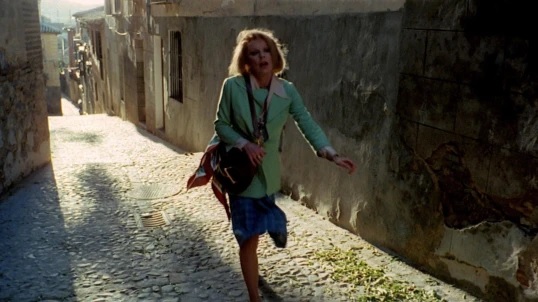Lisa and The Devil (reviewed by Lisa Marie Bowman)
Originally filmed in 1972 and tragically not seen the way it was intended to be seen until years after director Mario Bava’s death, Lisa and the Devil tells the story of Lisa (Elke Sommer), a tourist who is visiting the city of Toledo, Spain with a friend. From the first minute we see Lisa walking through the streets of the city, something seems to be off. The city seems strangely deserted. The streets themselves seem menacing, in much the same way that streets of Vienna did in The Third Man.
Lisa leaves her tour group and goes in a store. A menacing, bald man (Telly Savalas) gives Lisa a strange look as he buys a dummy. The man resembles a portrait of the devil that Lisa saw earlier. Running from the shop, Lisa runs into another man (Espartaco Santoni) who appears to be following her. The man appears to fall to hi death but, despite that, the man will return later. People have a way of returning in Lisa and the Devil.
Lisa’s tour group appears to have vanished. She eventually runs into a seemingly friendly couple (Sylvia Koscina and Eduardo Fajardo) who, along with their driver (Gabriee Tinti), agree to take Lisa back to her hotel. But instead, they somehow end up outside of a dilapidated, mannequin-filled mansion. When the car breaks down, the group is invited to spend the night by the Countess (Alida Valli, who also appeared in The Third Man), who lives in the mansion with her strange but handsome son, Maximilian (Alessio Oriano). Maximilian is still mourning his ex-girlfriend, Elena. Elena, we’re told, bore a striking resemblance to Lisa.
However, it turns out that the Countess and Maximilian are not alone in the mansion. Also living in the house is the Countess’s second husband, Carlos, who just happens to be the same man that was following Lisa in the city! And finally, there’s the butler, Leandro, who is the same man who Lisa earlier saw in the shop!
Lisa and the Devil is one of my favorite Italian horror films. Yes, some of that is because I shared the same name as the movie’s main character and I love it when people say my name a lot. But I would love this film even if Elke Sommer was playing someone named Annalise or Tiffany. Mario Bava said that this film, or at least his version of the film, was one of his most personal works and the entire movie does feel like a puzzle that only one person could possibly solve. In the movie, only Leandro seems to full understand what’s happening in both the city and the house. In real life, it’s likely that only Mario Bava understood everything that happened in the film. The film mixes a giallo mystery (because people do soon start to die the mansion) with a surreal exploration of memory, regret, sin, and guilt. The movie plays out like a waking dream, leaving us to wonder just who exactly Lisa truly is and who the Devil of the title might be. It’s easy to spot the Devil. It’s less easy to spot which parts of the film are meant to be reality and which parts might simply be happening in Lisa’s mind.
Unfortunately, the film’s producer had no idea what to do with Bava’s surreal masterpiece. The few people who saw the film were baffled. The Italian censors demanded massive cut for both sex and violence and, as a result, Lisa and the Devil was one of the few Bava films not to get a theatrical release in his native country. It apparently did play in South Korea and Spain, though the Spanish version did not feature Bava’s original, mind-twister of an ending.
Even worse, for the film’s American release, the film’s producer requested that Bava add some exorcism scenes so that the film could take advantage of the popularity of The Exorcist. By now realizing that his preferred version of the film would probably never be seen, Bava agreed. With the help of his son, Lamberto, Mario Bava shot several scenes featuring Elke Sommer acting possessed while a priest played by Robert Alda tried to exorcise the demon. The original Lisa and the Devil footage was presented as being scenes from the dimension Lisa’s soul had been sent to while the demon controlled her body. The film was retitled House of Exorcism in Amercia. And here’s the thing — House of Exorcism is hardly a bad movie. Bava is Bava, afterall. Sommer does a convincing job acting possessed and the mix of new and old footage is edited together fairly well. But it’s still not the film that Bava set out to make.
Sadly, Bava’s original version of Lisa and the Devil would not get a proper video release until decades after his death. It’s not always an easy film to follow. I’ve seen it several times and there are still things about it that I still don’t fully understand. It’s a surreal masterpiece, one that is perhaps not meant to be fully understood and the type of dream-film that shows why Bava is one of the few directors that David Lynch has regularly cited as being an influence on his own work. Lisa and the Devil is a trip through a world dominated by dark and disturbing things and it’s one of the best Italian horror films to come out of the 70s. Thankfully, it can now be seen the way that Bava intended.


